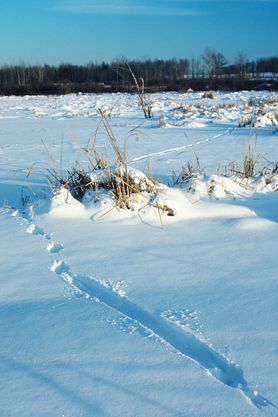Back in the day
There's plenty of life in dead of winter
Kathryn A. Kahler
The idea of winter walks, highlighted in this issue’s cover story, is nothing new.
George Knudsen was DNR’s chief naturalist and the author of countless articles and DNR publications. His short nature notes were a regular feature on the inside front cover of this magazine until he retired in the early 1980s.
In his book, “Nature Theme Hikes,” a compilation of 70 ideas for naturalist-led hikes, he cautioned naturalists against lecturing hikers, instead promoting a conversational approach to instilling an appreciation for nature.
One of his hikes, “Nature in Winter,” offers tips for identifying trees and shrubs by bark, buds, twigs and leaf scars; observing hibernating insects beneath loose bark on a rotten log; and how to find skunk cabbage fruits, liverworts, mosses and evergreen ferns on hillside seepages and in unfrozen swamps.
“When snow is exceptionally deep, as in drifts,” he wrote in that book entry, “try to explain how glaciers form and discuss how they actually moved by ‘plastic action.’”
Knudsen wrote another winter-themed piece for the January 1979 issue of Wisconsin Natural Resources, inviting readers to get out for “the fresh air, exercise and mental relaxation” of a winter nature hike. Excerpted here, it’s as timely now as it was then.
C’mon, take a winter nature hike
GEORGE J. KNUDSEN, Chief naturalist, DNR
 ©DNR FILESWinter hikes can reveal evidence of life in the dead of winter, like these tracks from an otter sliding through the snow.
©DNR FILESWinter hikes can reveal evidence of life in the dead of winter, like these tracks from an otter sliding through the snow.Winter is here! The ground is covered with snow and it’s cold outside, so the only thing to do is to stay in your house, watch TV and wait for spring, right?
Wrong! You can take an eye--opening, invigorating winter nature hike. If you are observant, you will be surprised at all the interesting, even exciting, things revealed by the winter landscape.
Most people hike on foot and that’s great, but cross-country skiing and snowshoeing are two excellent, quiet and increasingly popular ways to “hike,” too. And you snowmobilers can give your mechanical steeds a well--deserved rest while you hike awhile, warm up a bit and look around a lot.
State parks, state forests and other public lands are only a short drive for most Wisconsin folks. Some of you can hike on your own land and enjoy its winter offerings. Other private lands can also be used when permission is given by landowners.
No matter how short your hike will be, check the weather, dress warmly, wear waterproof footwear and a warm hat and gloves, and know where you’re going.
You can hike just for the fresh air, exercise and mental relaxation, or you can take a more specialized hike to see birds, animal signs, plants in winter or to take photographs. Or you can mix ’em all together and look for anything and everything.
Planning your route through a number of habitat types will greatly increase chances to see animals and their signs or to hear bird calls.
Dozens of species of resident and visiting birds inhabit Wisconsin in winter. They include: majestic bald eagles that can be seen flying or perched along open water stretches of the Wisconsin and Mississippi rivers; soaring red-tailed hawks; big chisel-billed, fiery-crested pileated woodpeckers; noisy, ever-alert blue jays; and tiny, sassy, scolding chickadees.
Mammals are generally more difficult to see than birds, but gray foxes and red squirrels are common exceptions, along with bounding cottontail rabbits. If you’re lucky, and quiet, you may see a deer, mink or weasel.
If you want to be an animal detective, look for the signs left by animals in freshly fallen, soft snow. Look for tracks of single animals, well-worn game trails, feathers, hair, droppings, tree dens, burrows in the snow and “forms” where animals have rested.
Where animals have fed is evidenced by gnawed, nibbled and nipped plants; empty nut shells and pine cone scales; wood chips on the snow below fresh holes made by woodpeckers; predator--killed animals, etc.
Follow a set of animal tracks and try to figure out what kind of animal made them, what it did along the way. If you see the tracks of “Bigfoot,” go home and watch TV.
Leafless but not lifeless trees and shrubs offer dandy silhouettes, bark colors and textures. Pines, cedars, spruces and firs, evergreen ferns, lichens and green mosses contrast nicely against the pure white snow.
The sea of snow itself and its snowdrift “tidal waves,” hoarfrost on trees, icicles, cold sparkling streams and fantastic sunsets (and sunrises, if you can get up) will add much to your adventures in Wisconsin’s snowy landscapes.
One final thought: When your fingers, toes, cheeks and nose are stinging from the cold, just remember that under that cold, cold snow lie the crisply frozen dead bodies of billions of mosquitoes. You’ll feel better instantly!
Kathryn A. Kahler is associate editor of Wisconsin Natural Resources magazine.

